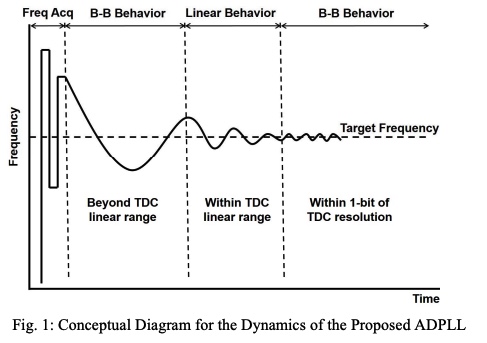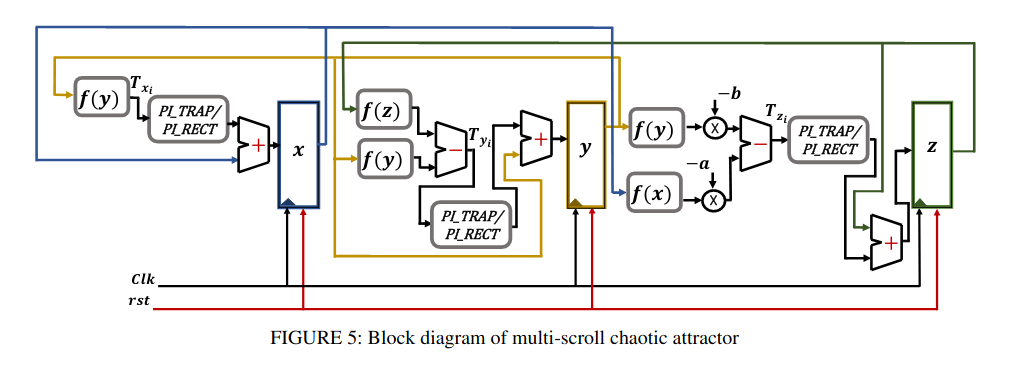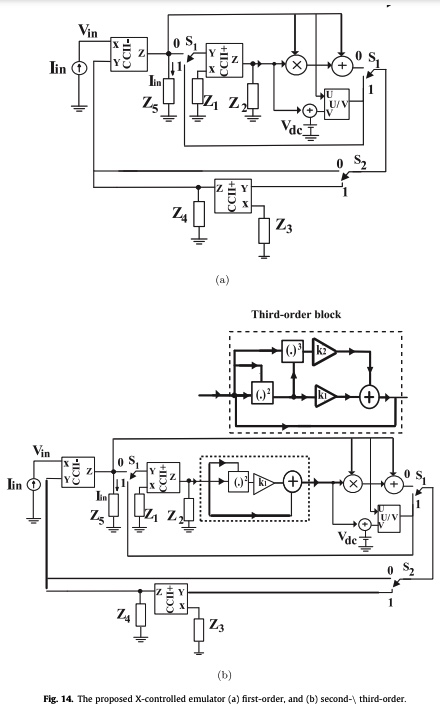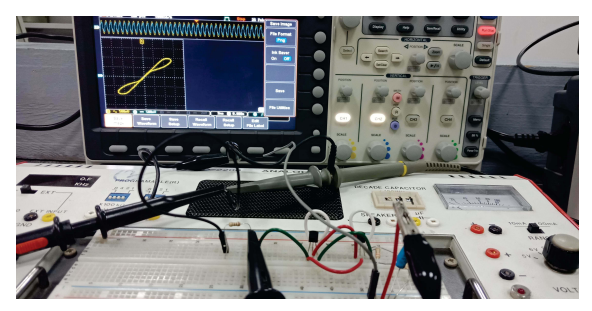
A fast locking hybrid TDC-BB ADPLL utilizing proportional derivative digital loop filter and power gated DCO
A hybrid Time to Digital Converter (TDC) - Bang Bang (BB) All Digital Phase Locked Loop (ADPLL) architecture is proposed to optimize power, area, lock time, and design complexity. The Hybrid ADPLL architecture utilizes a low resolution two synthesizable Time to Digital Converters to achieve fast lock time, and then switches to a Bang-Bang like architecture once it is in the locked state. Such hybrid architecture enables the ADPLL to achieve lock time in less than 1 μ sec using an adaptive proportional derivative digital loop filter while consuming a power of 5.1 mW when locked at 4GHz with 1
Fractional-Order Control Scheme for Q-S Chaos Synchronization
In this paper, a fast control scheme is presented for the problem of Q-S synchronization between fractional chaotic systems with different dimensions and orders. Using robust control law and Laplace transform, a synchronization approach is designed to achieve Q-S synchronization between n-D and m-D fractional-order chaotic systems in arbitrary dimension d. This paper provides further contribution to the topic of Q-S synchronization between fractional-order systems with different dimensions and introduces a general control scheme that can be applied to wide classes of fractional chaotic and
CNTFET design of a multiple-port ternary register file
Ternary number system offers higher information processing within the same number of digits when compared to binary systems. Such advantage motivated the development of ternary processing units especially with CNTFET which offers better power and delay results compared to CMOS-based realization. In this paper, we propose a variety of circuit realizations for the ternary memory elements that are needed in any processor including ternary D-latch, and ternary D-flip-flop. These basic building blocks are then used to design a ternary register file with multiple read and write ports. This paper is
Discretization of emperor penguins colony algorithms with application to modular product design
Modularity concepts attracted the attention of many researchers as it plays an important role in product design problems. Modularity requires dividing a product into a set of modules that are independent between each other and dependent within. The product is represented using Design Structure Matrix (DSM). DSM works as a system representation tool; it visualizes the interrelationship between product elements. In this research, a comparison is conducted between four optimization algorithms: Emperor Penguins Colony (EPC), First Modified Emperor Penguins Colony (MEPC1), Second Modified Emperor
Fractional X-shape controllable multi-scroll attractor with parameter effect and FPGA automatic design tool software
This paper proposes a new fractional-order multi-scrolls chaotic system. More complex systems and flexible ranges of the chaotic behavior are obtained due to the extra parameters added by the fractional-order. The proposed system has novel complex chaotic behaviors. The effect of changing the system parameters on the system behavior is investigated and their bifurcation diagrams have been provided. The MLE for the proposed system in integer and fractional domain has been discussed. It shows that the proposed chaotic system is richer in the case of fractional-order. A novel FPGA design
Control of continuous-time chaotic (hyperchaotic) systems: F-M synchronisation
In this paper, a new type of chaos synchronisation between different dimensional chaotic systems is proposed. The novel scheme is called F-M synchronisation, since it combines the inverse generalised synchronisation with the matrix projective synchronisation. In particular, the proposed approach enables F-M synchronisation to be achieved between n-dimensional master system and m-dimensional slave system in different dimensions. The technique, which exploits nonlinear controllers, stability property of integer-order linear continuous-time dynamical systems and Lyapunov stability theory, proves

FPGA implementation of integer/fractional chaotic systems
Chaotic systems have remarkable importance in capturing some complex features of the physical process. Recently, fractional calculus becomes a vigorous tool in characterizing the dynamics of complex systems. The fractional-order chaotic systems increase the chaotic behavior in new dimensions and add extra degrees of freedom, which increase system controllability. In this chapter, FPGA implementation of different integer and fractional-order chaotic systems is presented. The investigated integer-order systems include Chua double scroll chaotic system and the modified Chua N-scroll chaotic

Numerical Simulations and FPGA Implementations of Fractional-Order Systems Based on Product Integration Rules
Product integration (PI) rules are well known numerical techniques that are used to solve differential equations of integer and, recently, fractional orders. Due to the high memory dependency of the PI rules used in solving fractional-order systems (FOS), their hardware implementation is very difficult and resources-demanding. In this paper, modified versions of the PI rules are introduced to facilitate their digital implementations. The studied rules are PI rectangular, PI trapezoidal, and predict-evaluate-correct-evaluate (PECE) rules. The three modified versions of the PI rules are

A general emulator for fractional-order memristive elements with multiple pinched points and application
In this paper, X-controlled universal fractional-order memelements (FOMEs) emulator is proposed. The emulation circuit is realized using second-generation current conveyor (CCII) and analog voltage multiplier (AVM)/divider block with two switches to control the type of memelements and emulator mode. The effect of the fractional-order capacitor (FOC) on the pinched hysteresis loop (HL) area and the range of frequency is discussed at different fractional-order α. Additionally, the higher-order meminductor, memristor, memcapacitor, and inverse memristor are discussed presenting multiple pinched

A Simple BJT Inverse Memristor Emulator and Its Application in Chaotic Oscillators
A generalized inverse memristor emulator is proposed based on two BJT transistors as a diode connected with a first order parallel RC filter. The mathematical model of the circuit is presented where the pinched hysteresis loops (PHLs) with different periodic stimuli are analyzed. The numerical, P-Spice simulations and experimental results are presented indicating that the introduced emulator is a simple voltage-controlled generalized inverse memristor. The results show that the PHLs area is increased with increasing the applied frequency. In addition, the proposed emulator is employed in a
Pagination
- Previous page ‹‹
- Page 46
- Next page ››
